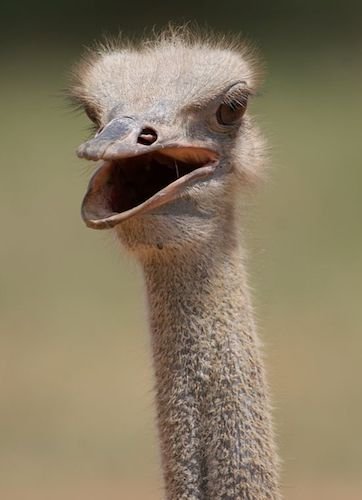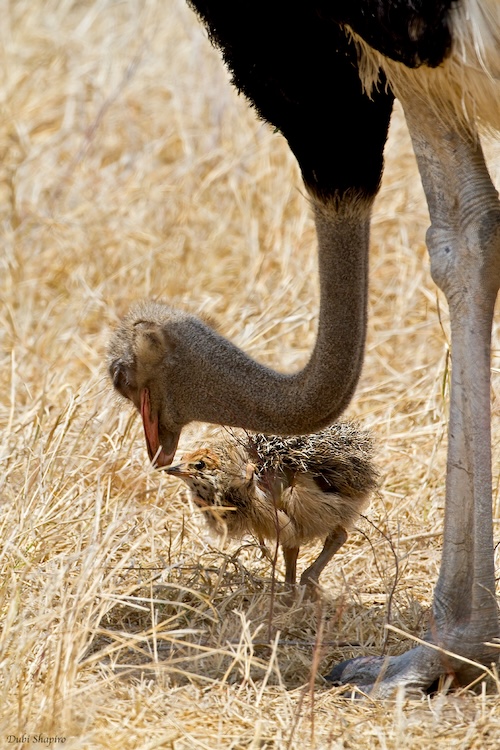Struthionidae – Ostriches

The Struthionidae is a family of huge flightless ratite birds which first appeared during the Eocene epoch. It is today represented by the sole living genus Struthio. (It also contains several extinct genera).
Traditionally the order Struthioniformes contained all the world’s ratites including kiwis, rheas, emus and cassowaries. However, recent genetic analysis has found that the group is not monophletyic, as it is paraphyletic in respect to the tinamous.
Ostriches can weigh as much as 150 kilos, reach more than two meters in height and can run at a sustained speed of 50 kph.
Mating patterns differ by geographical region, but territorial males fight for a harem of two to seven females. There is a dominant female and, while eggs are laid in a communal nest, the dominant female may discard the eggs of weak females. The eggs are incubated by the females by day and by the males by night. Typically, the male defends the hatchlings and teaches them to feed, although males and females do cooperate in rearing chicks which form a creche of mixed parentage. Among those ostriches which survive to adulthood, the species is one of the longest-living avian species. Common ostriches in captivity have lived to over sixty.
The common ostrich is farmed for its feathers, for its meat, which has a reputation for leanness, and for the leather made from its skin.

Common Ostrich Struthio camelus ©Dubi Shapiro
Molecular evidence indicates that the East African Rift has served as a geographic barrier to isolate the North African ostrich, while ecological and behavioural differences have kept it genetically distinct from the neighbouring Masai ostrich. An examination of the mitochondrial DNA of Struthio taxa, including the extinct Arabian ostrich Struthio camelus syriacus, has found that the Somali ostrich is phylogenetically the most distinct, appearing to have diverged from their common ancestor some 3.6 to 4.1 million years ago. Formerly considered just one species the IOC now recognises these two species in this family.
The Common Ostrich has three races, the nominate race camelus is mostly found in the west and south Sahara and Sahel; massaicus is found from southern Kenya to Tanzania and australis is found in southern Africa (and as a feral species in Australia).
-
Number of bird species: 2
(As at July 2025)
Just two members in this family:
Somali Ostrich Struthio molybdophanes
Common Ostrich Struthio camelus
-
Struthionidae
InformationStruthionidae s a family of flightless birds, containing the extant ostriches and their extinct relatives. The two extant species of ostrich are the common ostrich and Somali ostrich, both in the genus Struthio, which also contains several species known from Holocene fossils such as the Asian ostrich.
-
Common Ostrich Struthio camelus
IUCN Species StatusIUCN species profile... -
Common Ostrich Struthio camelus
Species AccountMassive, conspicuous, flightless bird with long neck and robust legs. Mature males have black-and-white plumage, with pinkish skin, flushed in breeding plumage. -
Common Ostrich Struthio camelus
Species AccountThe common ostrich (Struthio camelus), or simply ostrich, is a species of flightless bird native to certain areas of Africa. -
Common Ostrich Struthio camelus
Species AccountSound archive and distribution map... -
Somali Ostrich Struthio molybdophanes
Species AccountA long-legged and long-necked flightless bird. Males have a blue-gray neck and legs, but the bill and front of the legs become pink when breeding. -
Somali Ostrich Struthio molybdophanes
Species AccountThe Somali ostrich (Struthio molybdophanes), also known as the blue-necked ostrich, is a large flightless bird native to the Horn of Africa. -
Somali Ostrich Struthio molybdophanes
Species AccountSound archive and distribution map...
-
Somali Ostrich Added to List of Threatened Species
ArticleDid you know there are two species of ostrich? Don't worry if this is news to you—scientists didn't know that for sure either until this year, when the Somali ostrich (Struthio molybdophanes) of Ethiopia, Somalia, Djibouti and Kenya was declared a separate species from the common ostrich (S. camelus). Previously considered a subspecies, the Somali ostrich has now been added—along with 360 other newly discovered bird species—to the International Union for Conservation of Nature’s Red List of Threatened Species. The Red List update come from an assessment of the world's birds of prey, seabirds, water birds, owls and similar species (collectively known as nonpasserine birds, because all other birds come from the order Passeriformes) by the conservation organization BirdLife International...
-
Somali Ostrich Struthio molybdophanes
Video
